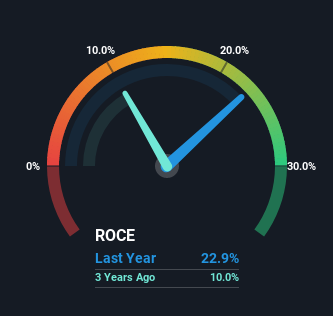Returns On Capital Are A Standout For Sangam (India) (NSE:SANGAMIND)

Finding a business that has the potential to grow substantially is not easy, but it is possible if we look at a few key financial metrics. Amongst other things, we'll want to see two things; firstly, a growing return on capital employed (ROCE) and secondly, an expansion in the company's amount of capital employed. Put simply, these types of businesses are compounding machines, meaning they are continually reinvesting their earnings at ever-higher rates of return. So when we looked at the ROCE trend of Sangam (India) (NSE:SANGAMIND) we really liked what we saw.
What Is Return On Capital Employed (ROCE)?
For those that aren't sure what ROCE is, it measures the amount of pre-tax profits a company can generate from the capital employed in its business. To calculate this metric for Sangam (India), this is the formula:
Return on Capital Employed = Earnings Before Interest and Tax (EBIT) ÷ (Total Assets - Current Liabilities)
0.23 = ₹2.6b ÷ (₹20b - ₹8.4b) (Based on the trailing twelve months to December 2022).
Therefore, Sangam (India) has an ROCE of 23%. In absolute terms that's a great return and it's even better than the Luxury industry average of 12%.
Check out our latest analysis for Sangam (India)

While the past is not representative of the future, it can be helpful to know how a company has performed historically, which is why we have this chart above. If you'd like to look at how Sangam (India) has performed in the past in other metrics, you can view this free graph of past earnings, revenue and cash flow.
What Can We Tell From Sangam (India)'s ROCE Trend?
Investors would be pleased with what's happening at Sangam (India). The data shows that returns on capital have increased substantially over the last five years to 23%. The company is effectively making more money per dollar of capital used, and it's worth noting that the amount of capital has increased too, by 28%. So we're very much inspired by what we're seeing at Sangam (India) thanks to its ability to profitably reinvest capital.
On a separate but related note, it's important to know that Sangam (India) has a current liabilities to total assets ratio of 43%, which we'd consider pretty high. This effectively means that suppliers (or short-term creditors) are funding a large portion of the business, so just be aware that this can introduce some elements of risk. Ideally we'd like to see this reduce as that would mean fewer obligations bearing risks.
Our Take On Sangam (India)'s ROCE
All in all, it's terrific to see that Sangam (India) is reaping the rewards from prior investments and is growing its capital base. And with the stock having performed exceptionally well over the last five years, these patterns are being accounted for by investors. So given the stock has proven it has promising trends, it's worth researching the company further to see if these trends are likely to persist.
On a separate note, we've found 3 warning signs for Sangam (India) you'll probably want to know about.
If you want to search for more stocks that have been earning high returns, check out this free list of stocks with solid balance sheets that are also earning high returns on equity.
New: Manage All Your Stock Portfolios in One Place
We've created the ultimate portfolio companion for stock investors, and it's free.
• Connect an unlimited number of Portfolios and see your total in one currency
• Be alerted to new Warning Signs or Risks via email or mobile
• Track the Fair Value of your stocks
Have feedback on this article? Concerned about the content? Get in touch with us directly. Alternatively, email editorial-team (at) simplywallst.com.
This article by Simply Wall St is general in nature. We provide commentary based on historical data and analyst forecasts only using an unbiased methodology and our articles are not intended to be financial advice. It does not constitute a recommendation to buy or sell any stock, and does not take account of your objectives, or your financial situation. We aim to bring you long-term focused analysis driven by fundamental data. Note that our analysis may not factor in the latest price-sensitive company announcements or qualitative material. Simply Wall St has no position in any stocks mentioned.
About NSEI:SANGAMIND
Sangam (India)
Engages in the manufacture and sale of PV-dyed yarns and denim fabrics in India.
Slight second-rate dividend payer.
Similar Companies
Market Insights
Community Narratives



